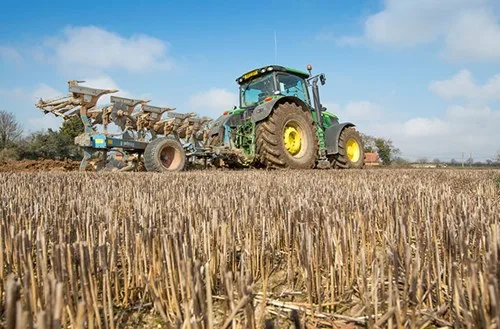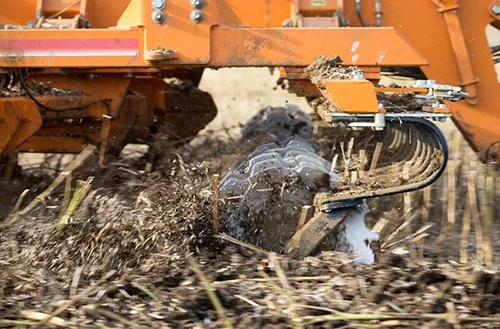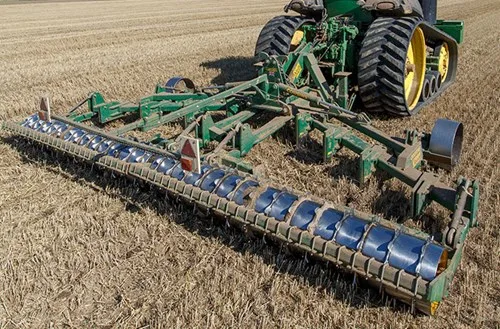
Black-grass control does not start with the pre-emergence herbicide programme. Doing everything possible to reduce the weed population before you drill the crop is key, and it means making good management decisions right from the off. Below is our guide to managing black-grass from harvest to drilling, starting with six general principles.
Don’t plan on the back of last season – the right decision depends on the conditions in the field. But always factor in previous seasons' cultivations to understand the black-grass seedbank.
Delayed drilling of winter wheat is a vital tool to control black-grass – cultivation needs to maximise the possible drilling window.
Cultivation and establishment needs to create conditions for healthy, vigorous crops that can compete with black-grass. There is often a compromise between the ideal drilling date for early vigour and missing the main autumn flush of black-grass.
Spring cropping is a reliable back-up option when autumn establishment is not possible. Cover crops can be a useful tool to establish spring crops and improve soil but the decision to use them needs to be made well in advance.
Disturbing soil can prompt black-grass germination so establishment of any crop should be lower disturbance than any preceding cultivation.
Good soil condition ensures good establishment and maximises crop competitiveness. It also contributes to good efficacy of pre-emergence herbicides.
Author
| 17th July 2023The Ultimate Guide to controlling black-grass before planting your next crop
There are three main cultivation strategy options for black-grass seed management after harvest.
Do nothing, do not disturb the surface and allow natural predation and germination to eliminate some seed before drilling the crop. Warm, sunny weather post-harvest is particularly favourable to this approach as seed can be damaged by light and heat.
Shallow cultivation in the top 2–3 inches to stimulate black-grass and create some tilth. Working carefully at this depth should ensure this season’s shed black-grass seed remains in the germination zone near the surface to produce a stale seedbed before drilling. Depending on soil type and condition this operation may be repeated several times.
Full inversion ploughing, useful for burying black-grass seed after significant seed shed and can also be used to remove widespread compaction in the field. For both compaction and black-grass the plough is a re-set button, but it has to be used sparingly, and must be done effectively, otherwise buried black-grass seed may be brought back to the surface to wreak havoc.

Match cultivation option to the field situation - soil condition and type, black-grass seedbank and crop all need to be considered.
Zero tillage, soil needs to be in good condition to establish an autumn cereal without any tillage. Direct drilled crops, particularly later in the autumn can be susceptible to a shortage of nitrogen as very little is mineralised and made available with this establishment technique. Improving biological profile of soils will help to increase the availability of nitrogen for crops.
Shallow non-inversion tillage can mineralise nitrogen and create a good seedbed for drilling into. Soil needs to be in reasonable condition at depth so that the seedbed doesn’t sit on top of a layer of compacted soil which will hamper drainage and rooting. On heavier soils, this process can be repeated several times to greatly reduce black-grass. On lighter soils and those prone to slumping, repeated cultivation is likely to damage the soil.
Deep non-inversion tillage removes any compaction to a greater depth than shallow tillage but tends to mix black-grass seeds from multiple seasons through the soil. This will lead to black-grass geminating from different depths at different times which will reduce the efficacy of late drilling and herbicides. This cultivation should generally be used when black-grass.

We Highly Recommend:
Set up machinery correctly
You’ve decided your strategy and what you want to achieve in your system. Now’s the time to make sure your machinery is set up correctly and won’t bring any unintended problems.
Drilling the crop with less disturbance and at a slightly shallower depth than any cultivation carried out beforehand is important to make stale seedbeds effective. Ensure the combination of kit on farm can achieve this.
Tractors should be able to run low pressure (<1bar) tyres to minimise the risk of compaction throughout all operations from harvest to drilling.
Ensure that the drill tractor doesn’t leave compaction during the drilling pass as this compaction is likely to cause problems – including reduced crop competitiveness – until next harvest.
Consider whether cultivation to remove compaction is dealing with a problem caused by machinery operation rather than something more fundamental in the soil. For example, is the problem avoidable by smaller equipment rather than being resolved by bigger kit.

Target compaction
Black-grass favours wet areas, and compacted soil layers can prevent water moving through the soil profile to drain away, so it is important to take steps to avoid and / or reduce compaction whenever possible.
The risk of compaction caused by the combine and other equipment depends on the season. Dry years like 2022 are a lower risk than wetter summers.
Operate machinery in tramlines, even in the harvest rush, to keep damage localised and easily identifiable.
Headlands and gateways are most at risk so check soil by digging down to look for compaction in likely problem areas first – low yield areas picked up by the combine yield monitor should also be investigated.
If compaction is present, target soil loosening to specific areas to correct the issue and avoid excessive surface disturbance. If it is present widely across the field, consider a deeper cultivation depending on black-grass pressure and field history.

Manage moisture
Too much or too little moisture can bring their own challenges, but it is important to manage it to successfully allow cultural control techniques to work effectively as possible.
Late drilling on heavy soils relies on good structure and moisture management to prevent waterlogging, slumping and ponding.
Take advantage of good soil structure and rooting from the previous crop.
A catch crop – even just volunteers and some weeds – can be helpful as it pumps moisture out of the soil during autumn and keeps the surface structure intact.
Cover crops work well before planned spring crops to improve structure and ability to travel.
All moisture management techniques can only do so much.

Consider residues
At harvest, deciding on how you will manage straw from the previous crop can be an important step in setting up what cultivation strategies might be open to you and appropriate.
If you're direct drilling, make sure the drill can cope with the stubble length on the field.
For baled straw, there should be no other residue management issues except the provisos that chaff is spread evenly, and baling contractors don’t bring black-grass seed onto the farm on their kit.
In other situations, evenness of chop and spread is essential so that all subsequent operations are dealing with a consistent level of residue on the soil surface.

Crop rotation
Obviously a key decision on the farm, and also for black-grass management. Good choices can make a major difference to successful weed management.
Consider the effect on the soil of crop rotation. Take advantage of crop rooting to improve soil structure without needing to cultivate, and the general benefits of rotations as part of effective weed management.
Of all the crops, oilseed rape responds best in unrestricted soil – so low disturbance loosening (if needed) before, and minimum cultivations after oilseed rape (given effective residue and slug management) is a logical choice in most cases.
Have a plan B for spring crops if autumn drilling is not possible.
